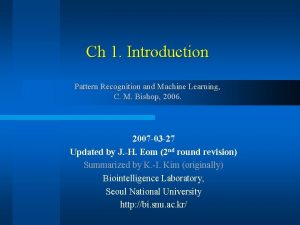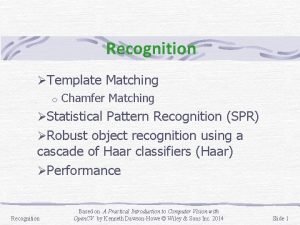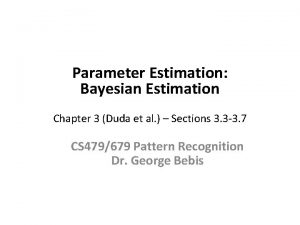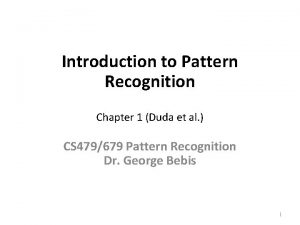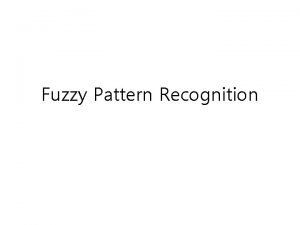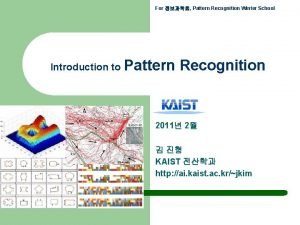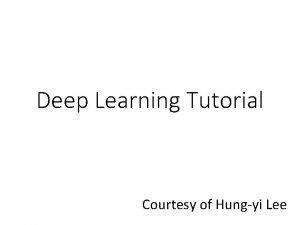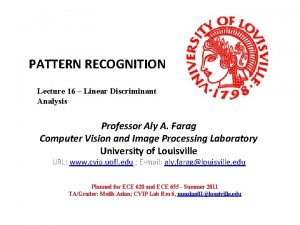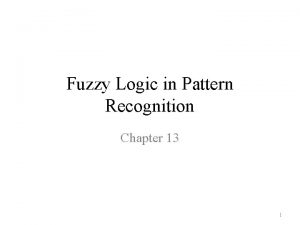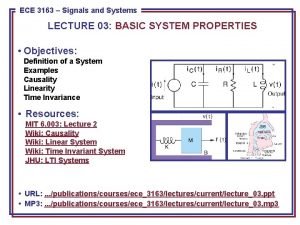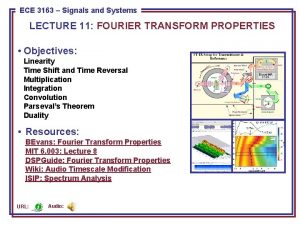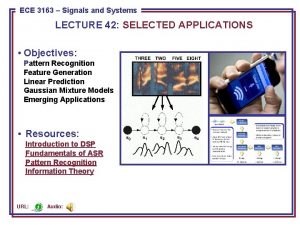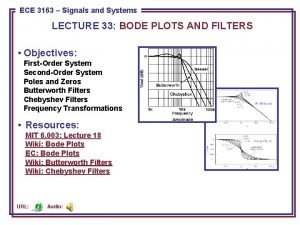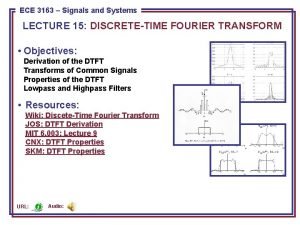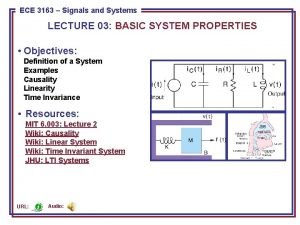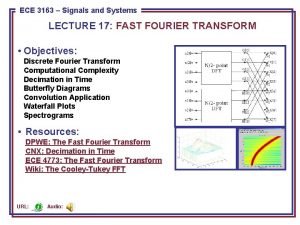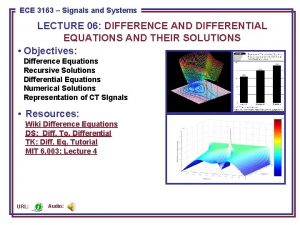ECE 3163 8443Signals Pattern and Recognition ECE Systems












- Slides: 12

ECE 3163 8443––Signals Pattern and Recognition ECE Systems LECTURE 18: FOURIER ANALYSIS OF CT SYSTEMS • Objectives: Response to a Sinusoidal Input Frequency Analysis of an RC Circuit Response to Periodic Inputs Response to Nonperiodic Inputs Analysis of Ideal Filters • Resources: Wiki: The RC Circuit CN: Response of an RC Circuit CNX: Ideal Filters URL: Audio:

Response of an LTI System to a Sinusoid • Consider an LTI CT system with impulse response h(t): • We will assume that the Fourier transform of h(t) exists: • The output can be computed using our Fourier transform properties: • Suppose the input is a sinusoid: • Using properties of the Fourier transform, we can compute the output: ECE 3163: Lecture 18, Slide 1

Example: RC Circuit • Using our FT properties: • Compute the frequency response: RC = 0. 001; W=0: 5000; H=(1/RC). /(j*w+1/RC); mag. H=abs(H); ang. H=180*angle(H)/pi; ECE 3163: Lecture 18, Slide 2

Example: RC Circuit (Cont. ) • We can compute the output for RC=0. 001 and 0=1000 rad/sec: • We can compute the output for RC=0. 001 and 0=3000 rad/sec: • Hence the circuit acts as a lowpass filter. Note the phase is not linear. • If the input was the sum of two sinewaves: describe the output. ECE 3163: Lecture 18, Slide 3

Response To Periodic Inputs • We can extend our example to all periodic signals using the Fourier series: • The output of an LTI system is: • We can write the Fourier series for the output as: • It is important to observe that since the spectrum of a periodic signal is a line spectrum, the output spectrum is simply a weighted version of the input, where the weights are found by sampling of the frequency response of the LTI system at multiples of the fundamental frequency, 0. ECE 3163: Lecture 18, Slide 4

Example: Rectangular Pulse Train and an RC Circuit • Recall the Fourier series for a periodic rectangular pulse: • Also recall the system response was: • The output can be easily written as: ECE 3163: Lecture 18, Slide 5

Example: Rectangular Pulse Train (Cont. ) • We can write a similar expression for the output: 1/RC = 1 • We can observe the implications of lowpass filtering this signal. • What aspects of the input signal give rise to high frequency components? 1/RC = 10 • What are the implications of increasing 1/RC in the circuit? • Why are the pulses increasingly rounded for lower values of 1/RC? • What causes the oscillations in the signal as 1/RC is increased? ECE 3163: Lecture 18, Slide 6 1/RC = 100

Response to Nonperiodic Inputs • We can recover the output in the time domain using the inverse transform: • These integrals are often hard to compute, so we try to circumvent them using transform tables and combinations of transform properties. • Consider the response of our RC circuit to a single pulse: • MATLAB code for the frequency response: RC=1; w=-40: . 3: 40; X=2*sin(w/2). /w; H=(1/RC). /(j*w+1/RC); Y=X. *H; mag. Y=abs(Y); ECE 3163: Lecture 18, Slide 7

Response to Nonperiodic Inputs (Cont. ) • We can recover the output using the inverse Fourier transform: syms X H Y y w X = 2*sin(w/2). /w; H=(1/RC). /(j*w+1/RC); Y=X. *H; Y=ifourier(Y); ezplot(y, [-1 5]); axis([-1 5 0 1. 5]) 1/RC = 10 ECE 3163: Lecture 18, Slide 8 1/RC = 10

Ideal Filters • The process of rejecting particular frequencies or a range of frequencies is called filtering. A system that has this characteristic is called a filter. • An ideal filter is a filter whose frequency response goes exactly to zero for some frequencies and whose magnitude response is exactly one for other ranges of frequencies. • To avoid phase distortion in the filtering process, an ideal filter should have a linear phase characteristic. Why? • We will see this “ideal” response has some important implications for the impulse response of the filter. • Lowpass • Highpass • Bandstop ECE 3163: Lecture 18, Slide 9

Ideal Linear Phase Lowpass Filter • Consider the ideal lowpass filter with frequency response: • Using the Fourier transform pair for a rectangular pulse, and applying the time-shift property: • Is this filter causal? • The frequency response of an ideal bandpass filter can be similarly defined: • Will this filter be physically realizable? Why? ECE 3163: Lecture 18, Slide 10 • Phase Response • Impulse Response

Summary • Showed that the response of a linear LTI system to a sinusoid is a sinusoid at the same frequency with a different amplitude and phase. • Demonstrated how to compute the change in amplitude and phase using the system’s Fourier transform. • Demonstrated this for a simple RC circuit. • Generalized this to periodic and nonperiodic signals. • Worked examples involving a periodic pulse train and a single pulse. • Introduced the concept of an ideal filter and discussed several types of ideal filters. • Noted that the ideal filter is a noncausal system and is not physically realizable. However, there are many ways to approximate ideal filters, and that is a topic known as filter design. ECE 3163: Lecture 18, Slide 11
 Cm bishop pattern recognition and machine learning
Cm bishop pattern recognition and machine learning Template matching pattern recognition
Template matching pattern recognition Bayesian parameter estimation in pattern recognition
Bayesian parameter estimation in pattern recognition Introduction to pattern recognition
Introduction to pattern recognition Fuzzy classification in pattern recognition
Fuzzy classification in pattern recognition Design cycle of pattern recognition
Design cycle of pattern recognition Pattern recognition
Pattern recognition Pattern recognition lab
Pattern recognition lab Pattern recognition clinical reasoning
Pattern recognition clinical reasoning Contoh pattern recognition
Contoh pattern recognition Discriminant function in pattern recognition
Discriminant function in pattern recognition Fuzzy logic in pattern recognition
Fuzzy logic in pattern recognition Pattern recognition
Pattern recognition
